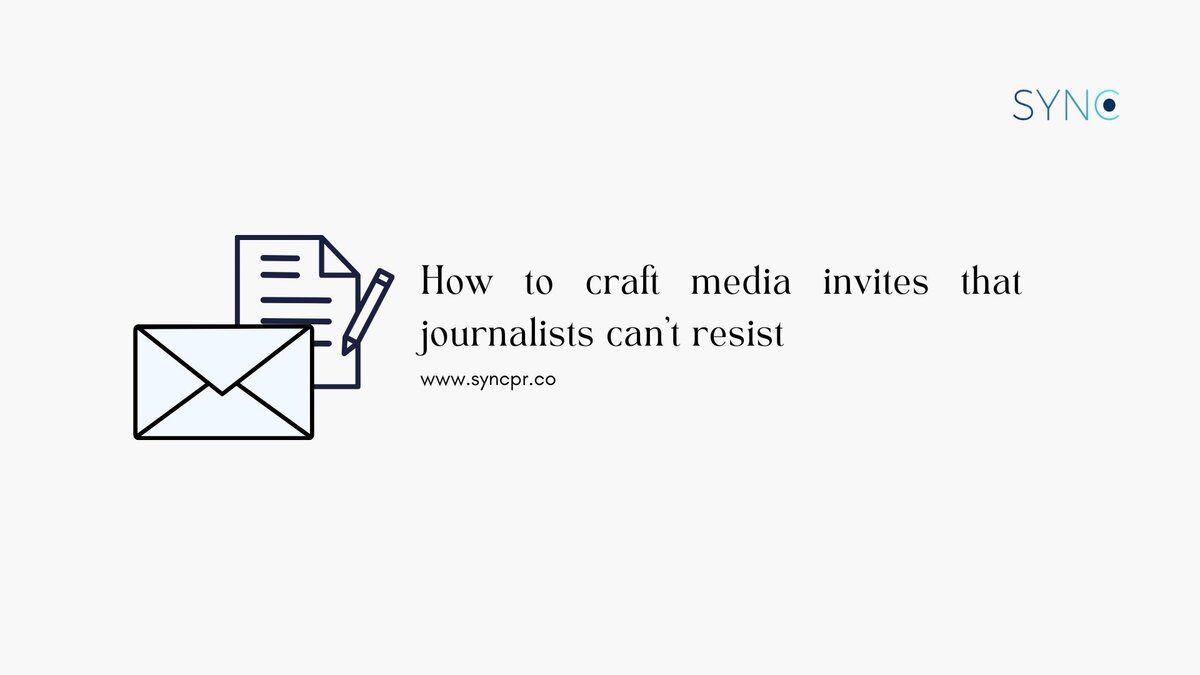Media invites can make or break an event and it is important to understand the craft of creating a compelling invite because events offer a powerful platform to enhance brand visibility and engagement.
Securing media coverage, particularly from local outlets, can dramatically amplify the impact of your event. Poor media attendance can lead to gaps in predicted outcomes, while the presence of quality media in good numbers can increase the success of an event. But how do we go about securing their attendance? How do we create a media invitation that journalists cannot resist?
Keep reading to learn how to craft media invites that journalists can’t resist!
What are media invites?
Before we delve deeper into crafting a media invite, we must first know what a media invitation is. More than just an invitation, a media invite is a strategic tool. It is crafted to capture the attention of journalists, editors, and media outlets and aims to secure valuable coverage for your event, announcement, or product launch. This meticulously designed communication provides essential details and compelling reasons why their participation or coverage would benefit them and their audience. By sparking interest and fostering engagement, it ultimately seeks to amplify the exposure and impact of your offering. Its ultimate goal is to increase the exposure and impact of your offering by generating interest and engagement.

The 5Ws of media invites
Crafting media invitations is no rocket science. Let’s look at the essential elements of a media invitation:
- What is the event about?
You should use no more than 20 words to convey the goal of the event, together with the name, date, and location. This is similar to a 30-second elevator pitch.
- When is the event?
Precisely mention the date and time range of the event or the deadline for responding to the invitation. Remember to set a clear deadline for journalists to RSVP or confirm their attendance, allowing you to manage logistics effectively. - Where is the event held?
Clearly state the physical address or venue where the event will take place. Include directions or accessibility information if necessary. If the event has a virtual component, clearly explain how journalists can participate remotely (platform used, login information, etc.) - Why should I (the media) attend?
Newsworthiness: Articulate why the event is newsworthy and relevant to the target audience. Emphasise angles that resonate with current trends or local issues. Explain how attending or covering the event benefits the media outlet and its audience. Offer exclusive interviews, access to key figures, or unique visuals. - Who’s event is this?
- Your Organisation: Establish your organisation’s credibility and expertise. Briefly mention your mission or track record to demonstrate relevance to the media outlet’s audience.
- Guest of honour/chief guest: On another note, always mention the chief guest attending the event – this will increase the chance of gaining media attendance.
Some other things to note and consider when crafting media invites are:
- Start with a strong headline: Journalists are bombarded with information – so capturing their attention in your media invite requires an irresistible hook. Use sensory language that paints a vivid picture (“Bigger, better, bomb-tastic”) and create a sense of urgency or exclusivity (“Limited Media Spots Available!”). Remember, every word counts, so keep it concise and impactful.
- Include strong visuals: Strong visuals are more than just window dressing – they’re essential storytelling tools. Include high-quality, relevant images that tell a story at a glance (action shots, product close-ups, or venue panoramas). Consider infographics or short video teasers that showcase data, statistics, or event highlights. Make sure visuals are clear, accessible, and correctly attributed.
- Focus on the angle: Connect your event to current trends or local issues, making it relevant to the journalist’s audience. Offer exclusive access or interviews with key figures, creating added value for them. Don’t shy away from presenting a human interest element that highlights the impact or emotional connection. And sometimes, a well-placed challenge to conventional thinking can spark debate and intrigue.
How to tailor media invites based on different types of media
- National TV channels
When approaching national or local television stations, remember that they are visual mediums. They prefer dynamic footage and excerpts. When inviting them, highlight any visually appealing aspects of your event. Offer them exclusive excerpts or interviews, and recommend prospective angles for the spokesperson. This simplifies their job and increases the likelihood of your event being listed prominently. - Broadcasters
Radio is all about the audio experience. When inviting broadcasting stations, consider the sounds of your event. Do you have exciting interviews or excerpts from any music or talks that will be featured? Consider scheduling a live broadcast of the event or an exclusive pre-event interview. - Newspapers, online publications, magazines
Written media channels, such as newspapers, magazines, and online publications, prioritise in-depth information. They enjoy well-researched press releases accompanied by high-quality photos. When contacting them, present them with all the necessary information regarding your event, and consider offering unique insights or interviews. High-resolution images, particularly those that capture the essence of your event, can be highly beneficial. This enables journalists and editors to see the story they can tell.
When to send out media invites?
Now you know how to craft a good media invite, what to include, and how to tailor the invites based on specific media. But when should you send the media invitation? Journalists receive around 20 media invitations a week and up to 26 pitches a day. They also frequently work on tight deadlines; thus, sending the invite at least 3 weeks to a month before the event is vital, giving your invitees time to make changes to their calendar if required. Typically, It is common to send another one a few days before the event to serve as a reminder.
You may also follow up with a phone call to check that the media received the invitation. However, you should proceed cautiously because you do not want to appear overbearing. You must balance getting the word out and not bugging the media about your event.
Post-outreach steps
After you’ve sent out your media invites, don’t sit back and wait. Consider calling or sending a follow-up email to your invitees about one week before the event. This is more than just poking them; it’s an opportunity to renew their interest and answer any queries they may have. It also helps you determine how many media representatives to expect. Everyone is busy, and a simple reminder should keep your event on their radar.
To sum up
A successful event isn’t just about how many people show up but also about how much it affects the community; the media can help with that. Getting good media coverage and writing a press release that grabs attention are both critical skills. Building relationships with journalists and influencers takes time and effort. Remember, even smaller journalists get lots of messages, so it’s important to personalise your approach and show that you care more than just what you want. That’s where well-written media invites come into play.
Ready to elevate your event with impactful media invites that capture attention and ensure widespread coverage? Contact SYNC PR today and let our experienced team craft compelling media invites tailored to your event’s unique story and audience. With our expertise, your event is poised for success. Reach out now to hello(a)syncpr.co. to spark interest, engage your audience, and make your event unforgettable!

